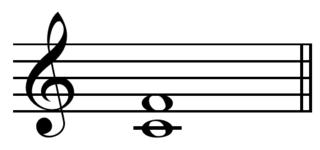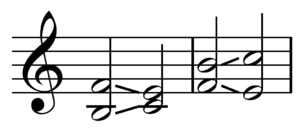
In music theory, counterpoint is the relationship of two or more simultaneous musical lines that are harmonically interdependent yet independent in rhythm and melodic contour. The term originates from the Latin punctus contra punctum meaning "point against point", i.e. "note against note". John Rahn describes counterpoint as follows:
It is hard to write a beautiful song. It is harder to write several individually beautiful songs that, when sung simultaneously, sound as a more beautiful polyphonic whole. The internal structures that create each of the voices separately must contribute to the emergent structure of the polyphony, which in turn must reinforce and comment on the structures of the individual voices. The way that is accomplished in detail is ... 'counterpoint'.

In music, harmony is the concept of combining different sounds together in order to create new, distinct musical ideas. Theories of harmony seek to describe or explain the effects created by distinct pitches or tones coinciding with one another; harmonic objects such as chords, textures and tonalities are identified, defined, and categorized in the development of these theories. Harmony is broadly understood to involve both a "vertical" dimension (frequency-space) and a "horizontal" dimension (time-space), and often overlaps with related musical concepts such as melody, timbre, and form.
In music, the tonic is the first scale degree of the diatonic scale and the tonal center or final resolution tone that is commonly used in the final cadence in tonal classical music, popular music, and traditional music. In the movable do solfège system, the tonic note is sung as do. More generally, the tonic is the note upon which all other notes of a piece are hierarchically referenced. Scales are named after their tonics: for instance, the tonic of the C major scale is the note C.
In music theory, the key of a piece is the group of pitches, or scale, that forms the basis of a musical composition in Western classical music, art music, and pop music.
Tonality or key: Music which uses the notes of a particular scale is said to be "in the key of" that scale or in the tonality of that scale.

A fourth is a musical interval encompassing four staff positions in the music notation of Western culture, and a perfect fourth is the fourth spanning five semitones. For example, the ascending interval from C to the next F is a perfect fourth, because the note F is the fifth semitone above C, and there are four staff positions between C and F. Diminished and augmented fourths span the same number of staff positions, but consist of a different number of semitones.

In music, a chord is a group of three or more notes played simultaneously, typically consisting of a root note, a third, and a fifth. Chords are the building blocks of harmony and form the harmonic foundation of a piece of music. They can be major, minor, diminished, augmented, or extended, depending on the intervals between the notes and their arrangement. Chords provide the harmonic support and coloration that accompany melodies and contribute to the overall sound and mood of a musical composition. For many practical and theoretical purposes, arpeggios and other types of broken chords may also be considered as chords in the right musical context.
A secondary chord is an analytical label for a specific harmonic device that is prevalent in the tonal idiom of Western music beginning in the common practice period: the use of diatonic functions for tonicization.
A nonchord tone (NCT), nonharmonic tone, or embellishing tone is a note in a piece of music or song that is not part of the implied or expressed chord set out by the harmonic framework. In contrast, a chord tone is a note that is a part of the functional chord. Nonchord tones are most often discussed in the context of the common practice period of classical music, but the term can also be used in the analysis of other types of tonal music, such as Western popular music.
In Western musical theory, a cadence is the end of a phrase in which the melody or harmony creates a sense of full or partial resolution, especially in music of the 16th century onwards. A harmonic cadence is a progression of two or more chords that concludes a phrase, section, or piece of music. A rhythmic cadence is a characteristic rhythmic pattern that indicates the end of a phrase. A cadence can be labeled "weak" or "strong" depending on the impression of finality it gives.
A suspended chord is a musical chord in which the third is omitted and replaced with a perfect fourth or a major second. The lack of a minor or a major third in the chord creates an open sound, while the dissonance between the fourth and fifth or second and root creates tension. When using popular-music symbols, they are indicated by the symbols "sus4" and "sus2". For example, the suspended fourth and second chords built on C (C–E–G), written as Csus4 and Csus2, have pitches C–F-G and C–D-G, respectively.
Chromaticism is a compositional technique interspersing the primary diatonic pitches and chords with other pitches of the chromatic scale. In simple terms, within each octave, diatonic music uses only seven different notes, rather than the twelve available on a standard piano keyboard. Music is chromatic when it uses more than just these seven notes.
In music, a pedal point is a sustained tone, typically in the bass, during which at least one foreign harmony is sounded in the other parts. A pedal point sometimes functions as a "non-chord tone", placing it in the categories alongside suspensions, retardations, and passing tones. However, the pedal point is unique among non-chord tones, "in that it begins on a consonance, sustains through another chord as a dissonance until the harmony", not the non-chord tone, "resolves back to a consonance".
In music theory, a dominant seventh chord, or major minor seventh chord, is a seventh chord composed of a root, major third, perfect fifth, and minor seventh; thus it is a major triad together with a minor seventh. It is often denoted by the letter name of the chord root and a superscript "7". In most cases, dominant seventh chord are built on the fifth degree of the major scale. An example is the dominant seventh chord built on G, written as G7, having pitches G–B–D–F:

In music, consonance and dissonance are categorizations of simultaneous or successive sounds. Within the Western tradition, some listeners associate consonance with sweetness, pleasantness, and acceptability, and dissonance with harshness, unpleasantness, or unacceptability, although there is broad acknowledgement that this depends also on familiarity and musical expertise. The terms form a structural dichotomy in which they define each other by mutual exclusion: a consonance is what is not dissonant, and a dissonance is what is not consonant. However, a finer consideration shows that the distinction forms a gradation, from the most consonant to the most dissonant. In casual discourse, as German composer and music theorist Paul Hindemith stressed,

The Andalusian cadence is a term adopted from flamenco music for a chord progression comprising four chords descending stepwise – a iv–III–II–I progression with respect to the Phrygian mode or i–VII–VI–V progression with respect to the Aeolian mode (minor). It is otherwise known as the minor descending tetrachord. Traceable back to the Renaissance, its effective sonorities made it one of the most popular progressions in classical music.

The second inversion of a chord is the voicing of a triad, seventh chord, or ninth chord in which the fifth of the chord is the bass note. In this inversion, the bass note and the root of the chord are a fourth apart which traditionally qualifies as a dissonance. There is therefore a tendency for movement and resolution. In notation form, it is referred to with a c following the chord position. In figured bass, a second-inversion triad is a 6
4 chord, while a second-inversion seventh chord is a 4
3 chord.
Inversions are not restricted to the same number of tones as the original chord, nor to any fixed order of tones except with regard to the interval between the root, or its octave, and the bass note, hence, great variety results.
In music, the dominant is the fifth scale degree of the diatonic scale. It is called the dominant because it is second in importance to the first scale degree, the tonic. In the movable do solfège system, the dominant note is sung as "So(l)".
Post-tonal music theory is the set of theories put forward to describe music written outside of, or 'after', the tonal system of the common practice period. It revolves around the idea of 'emancipating dissonance', that is, freeing the structure of music from the familiar harmonic patterns that are derived from natural overtones. As music becomes more complex, dissonance becomes indistinguishable from consonance.

In tonal music, a preparation is the consonant pitch or chord which precedes a dissonant nonharmonic tone. The move from a dissonance to a consonance constitutes a resolution.
Vogel's Tonnetz is a graphical and mathematical representation of the scale range of just intonation, introduced by German music theorist Martin Vogel 1976 in his book Die Lehre von den Tonbeziehungen. The graphical representation is based on Euler's Tonnetz, adding a third dimension for just sevenths to the two dimensions for just fifths and just thirds. It serves to illustrate and analyze chords and their relations. The four-dimensional mathematical representation including octaves allows the Evaluation of the congruency of harmonics of chords depending on the tonal material. It can thus also serve to determine the optimal tonal material for a certain chord.











